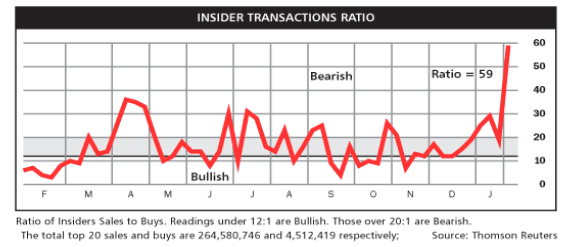Whenever my family goes to a new restaurant, I’ll ask our waitress what’s good there.
My son doesn’t understand why I don’t just get chicken tenders everywhere because those are always good. I’ll explain to him that the waitress knows what is cooked the best because she works there and has heard other patrons’ feedback.
She may just give me a pitch to order a high-priced entree, but even this spiel usually tells me what the restaurant is known for.
This inside advice is valuable when you are buying an expensive dinner, but it’s this same insight we wish we could get honestly from the company of any given stock in the market: “Are your shares a good buy now?”
Fortunately, there’s a way to get the inside scoop…
What’s Good Here?
Right now, companies are struggling to convince me they are good buys because of one simple measure of their sentiment — the insider transactions ratio (ITR).
ITR tracks the new buys and sells of any officer, director or owner of 10% or more of a company’s outstanding stock. Those transactions are tracked and turned into a ratio, showing how many buys there are compared to sells.
In this case, a high ratio indicates significantly more sellers than buyers, while a low ratio means fewer sellers and a modest amount of buyers.
This information is useful because these insiders are people who are extremely knowledgeable about the current environment of each company they are buying or sell shares of.
Sure, there are numerous reasons why either transaction could happen, so believing that you know where the stock is heading from one buy or sell order is ludicrous.
However, when you start to see several insiders selling or buying within days of each other … now that should catch your attention.
When multiple highly knowledgeable insiders are taking the same action — in this case selling — it’s not because they are all cashing out to buy their children cars for their graduations. Instead, it implies something internally in the company is off, and they expect shares to decline in the coming weeks.
The Main Course
ITR is a common, helpful indicator to follow on specific companies, but it’s also helpful to watch in the overall market — it gives us a broad idea of where the market is heading.
That’s why we are taking a look at insider selling and buying on a wide scale today. The chart below shows insider trading across the U.S. stock market during 2016 and the beginning of 2017:

You can see in the notes at the bottom of the chart that below 12 is considered bullish, while above 20 is considered bearish. The red fever line is generally static — meaning it bounces around steadily — so I like to track anomalies or when it is at extremes.
The latest jump up to the 59:1 ratio is clearly an extreme on the chart. In fact, it’s the highest we have seen in the past two years.
The last time ITR spiked above 60 was mid-January of 2014 — almost exactly three years ago.
After that spike, the market dipped more than 5% in quick fashion.
Over the last two years, there were two instances of spikes sending the ratio to near the 40:1 mark, as you can see happened in April 2016 in the chart above. After that spike, the market basically moved sideways in the following few months, with a somewhat scary spike in late June.
The previous spike before April was in October 2015, and over the following months, the S&P 500 experienced a 10% drop — a pretty significant move.
A Tip to Remember
This ratio is not a great market crash indicator.
It is, rather, pretty consistent at determining periods of sideways market moves, as we have seen since mid-December — or a looming sell-off.
That’s why the recent spike to 59:1 is alarming.
This means corporate insiders are selling their holdings at a pace of 59 sell orders to just one buy order … which tells me this isn’t a market environment I want to be buying in.
If you’re a long-term investor, then market dips and even a possible correction are not a problem — in fact, they are great times to add to your positions.
But for traders, who may hold positions for a year or less, these dips can crush your returns.
That’s why we spend countless hours each day tracking seemingly insignificant metrics like the ITR, looking for extreme levels or other clues that help us determine the market direction in the coming months.
Right now, this indicator is telling me it’s a cautious time for short-term holding strategies.
Regards,
Chad Shoop, CMT

Editor, Pure Income
P.S. While there are many companies you should be wary of investing in, there are also plenty of companies out there on the verge of making huge gains. In fact, an average of 43 stocks rally more than 1,000% each year. My colleague Paul will be hosting his Extreme Fortunes Summit webinar to teach you how to pick these incredible stocks before everyone else catches on. Click here to sign up to attend Paul’s special summit and learn his unique strategy.








